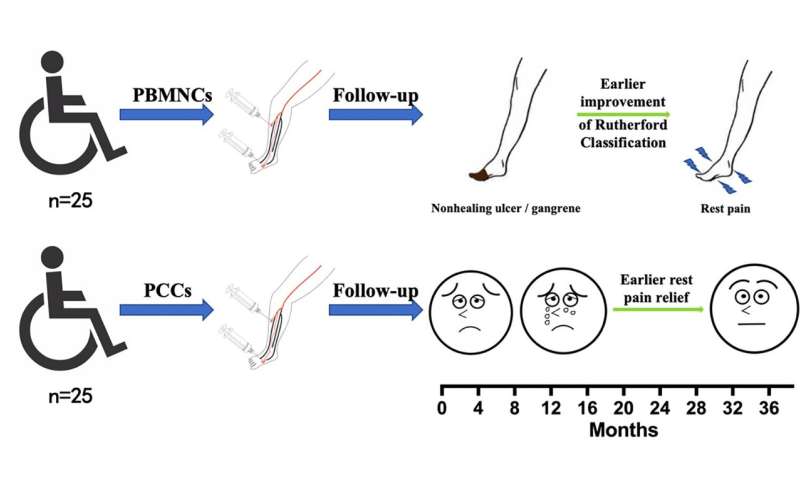
Mid-term results of the first clinical trial designed specifically to evaluate the safety and effectiveness of two cell therapies that are showing early promise in treating angiitis-induced critical limb ischemia were released today in STEM CELLS Translational Medicine. The study, by researchers at Zhongshan Hospital/Fudan University in Shanghai, compared how transplantation of peripheral blood mononuclear cells fared versus transplantation of purified CD34+ cells in treating this condition.
It revealed both therapies yielded satisfactory results and provided evidence for more precise application of cell therapy under different conditions, the researchers say.
Critical limb ischemia (CLI) is a type of peripheral artery disease caused by severe blockage in the arteries of the lower extremities, which markedly reduces blood-flow. Angiitis-induced CLI (AICLI) occurs when the CLI is the result of inflammation of the walls of small blood vessels. This chronic condition results in severe pain in the feet or toes, even while resting. Left untreated, the complications of CLI often result in amputation.
“Cell transplantation, such as purified CD34+ cells (PCCs), which are multipotent hematopoietic stem cells, and peripheral blood mononuclear cells (PBMNCs), which are a mixture of highly specialized immune cells including T cells, NK cells and more, is gradually being used as a promising treatment for AICLI,” explained Zhihui Dong, M.D, who along with Weiguo Fu, M.D, led the investigation. “The aim of our trial was to compare the mid-term safety and efficacy between the two groups and determine their respective advantages.”
From April 2014 to September 2019, 50 AICLI patients were equally allocated to the two treatment groups. At the 36-month follow-up, 47 patients remained. The endpoints assessed were major amputation-free survival and total amputation-free survival. At six months after treatment these had been 96 percent and 84 percent in the PBMNCs group, and 96 percent and 72 percent in the PCCs group, respectively—rates that remained stable at the 12- and 24-month periods, too. The mid-term trial period focused on in this report—36 months—once again confirmed stability.
“The PCCs group had a significant higher probability of earlier rest pain relief than the PBMNCs group, while earlier significant improvements in the Rutherford classification (which describes seven stages of peripheral artery disease) were observed in the PBMNCs group. Accordingly, PCCs would be preferred for patients with significant pain, while PBMNCs may be a good option for patients with two or more critically ischemic limbs,” Dr. Fu noted.
Additionally the study compared the therapies’ cost effectiveness and found that PCCs treatment was less cost-effective compared to PBMNCs treatment, mainly due to the extra cost of the purification process. “This finding is interesting and useful for future clinical trials in which we could consider avoiding purifying PBMNC into PCCs, thus reducing the cost of trials,” Dr. Dong said. “The next step should be to verify our outcomes in long-term trials involving larger numbers of patients.”
Source: Read Full Article
